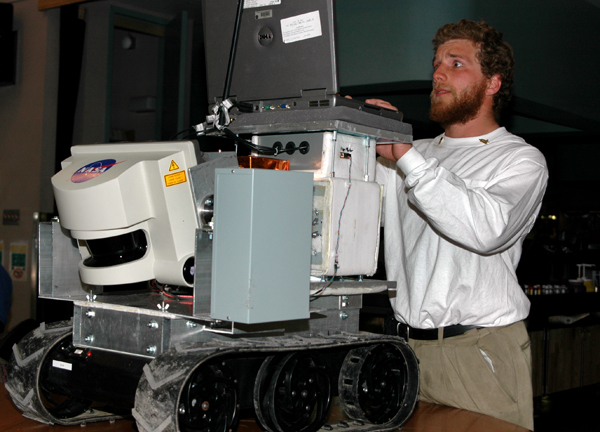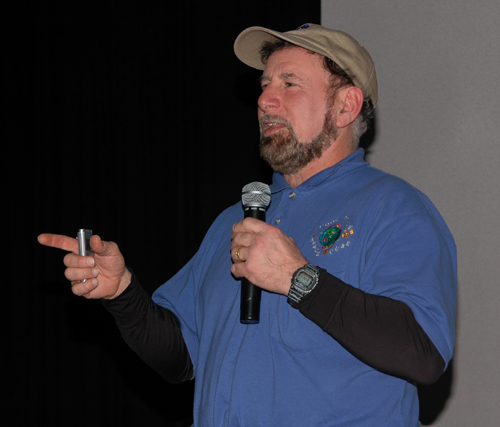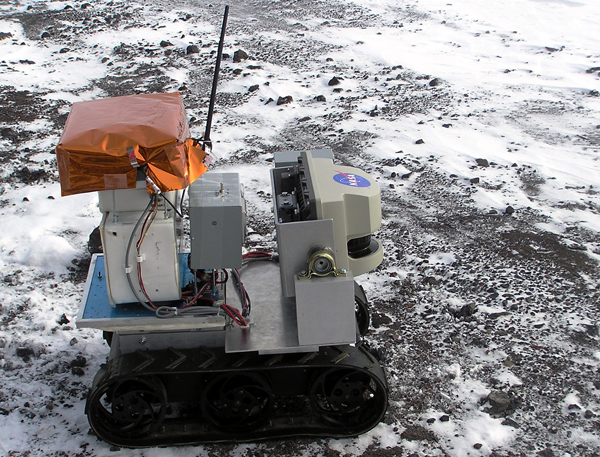
Photo Credit: Peter Rejcek |
Steve Strasburg prepares the NASAbot for a demonstration at McMurdo Station. The robotic vehicle carries a number of systems that NASA wants to test for eventual use on missions to the moon and Mars. |
Phone home
NASA uses robot to test communication systems from Antarctica for future space missions
By Peter Rejcek, Antarctic Sun Editor
Posted February 1, 2008
Mike Comberiate is a man who doesn’t lose count. Maybe it’s a quirk of being a NASA “rocket scientist” with the Goddard Space Flight Center (GSFC).
In rapid-fire dialogue, Comberiate proudly notes this current trip to Antarctica marks his 99th project here on an ongoing program dubbed COOLSPACE — Communications Over Obscure Locations Special Purpose Advanced Communications Equipment.
Distill that long title and you learn that Comberiate and his colleagues determine how to communicate between points A and B. The problem could be linking a phone call between the north and south poles — or crossing outer space from Earth to speak to robots exploring the surface of Mars.
This time around, Comberiate and his team of engineers and students are using a small robotic vehicle to test a host of systems that NASA may use in future planetary mission, as well as in more immediate operations like a maintenance flight to the Hubble Space Telescope. The project acronym in this case is GREAT (Goddard Robotics for Exploration and Avionics Testing).
“It’s an engineering model which is being used to test avionics that are flying on our Hubble missions,” Comberiate explained of the tracked vehicle. “It’s a mobile test bed.”
University students mentored by GSFC engineers like Comberiate built the tank-shaped robot and its various systems. It features a LADAR (Laser Detection and Ranging) scanner that uses an infrared laser beam to create a 180-degree image of the area in front of the robot. Each new scan is electronically stitched into a depth-of-field map that a remote operator can use to maneuver the robot around obstacles.
The image created by the LADAR is not a true picture, but a multi-colored abstraction that looks a bit like the science fiction view from the perspective of the Predator alien in the popular movie series. In the case of the NASA robot, the different colors represent distance, and the image is accurate to 1 millimeter in an 80-meter-deep view.
A shakedown of the robot’s laser scanning system indoors and outdoors near McMurdo Station went well. The indoor images consisted of recognizable shapes, like people and desks, with a variety of depths. The outdoor scans were a little more boring, said Steve Strasburg, an electrical engineering senior at George Mason University in Virginia.
“It’s very flat, few rocks and actually a lot of ice in this case,” he said during a presentation of the NASAbot to the McMurdo community. “It’s similar to Mars in that it’s very flat. You have different contours. The rover will be at angles at certain times and you’re going to have to do a little work to stitch everything together. … Overall, it gives a very precise point map image of where everything is.”

Photo Credit: Peter Rejcek
NASA Mike Comberiate.
The real tests took place farther in the field, at a camp called New Harbor in the McMurdo Dry Valleys and out on the Ross Ice Shelf. The objective was to have an operator in the United States interface with the robot through a complex communications system that ensures no data are lost as the signal bounces thousands of kilometers around the world.
The system is called the Delay/Disruption-Tolerant Networking (DTN), which prevents loss of data due to interruptions or long-haul delays in the connectivity link, Comberiate said. DTN shuttles information from one “node” in the communications link to the next until it reaches the end point. Comberiate likened it to a UPS delivery system that allows him to track the data package along its route.
“The end-to-end link to the USA has a long delay and is subject to unpredictable dropouts,” he explained. “[The National Science Foundation] and NASA need to deal with this situation as we attempt to do more sophisticated science in extremely remote locations.
“These long-haul connections are pretty realistic for anything that you could do on Earth,” he said of the Antarctic test scenario in the Dry Valleys.

Photo Credit: MIke Comberiate
The robotic vehicle in the field.
Another experiment involves the “Space Cube,” a new processing system using commercially available parts that can withstand severe space radiation without degrading. The system, which can fit in the palm of your hand, consists of four personal computers that can be reconfigured remotely — a Radio Shack-worth of hardware in a Rubik’s Cube-sized box.
“The architecture is such is that they’re rad tolerant — they don’t get destroyed by the radiation,” Comberiate said. “We are testing its ruggedness in extreme environments. It appears to have direct application in autonomous, unmanned science instrumentation … left in Antarctica or in the north polar region.”
Post-Antarctic plans will take the team to Barrow, Alaska, where it will demonstrate the instruments to International Polar Year scientists working in the Arctic.
“Whatever we can do here will help us with the flight program because it costs a lot of money to simulate things,” Comberiate said. “We’re doing it here in a world that is very similar.”
It’s a world that Comberiate has visited on and off for the last 25 years, a place where he has helped pioneer communication milestones from Antarctica, including the first Pole-to-Pole phone call using NASA’s original Tracking and Data Relay Satellite (TDRS-1) to connect to the South Pole to the North Pole in 1999.
The satellite’s high-speed connectivity was also instrumental in 1998 at the South Pole Station when during a teleconference doctors in the United States guided a welder through a real operation on the station’s doctor, who had been diagnosed with breast cancer.
For Comberiate, who once built instruments that landed on the moon during the heady days of the space race, working in Antarctica offers him the opportunity to keep the pioneering science spirit alive.
“I can make more of a personal impact in Antarctica because when you’re working on the moon, there are so many people involved that if you die, it still goes on anyway,” he said.








